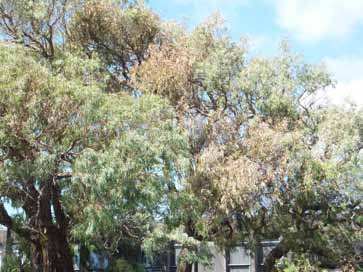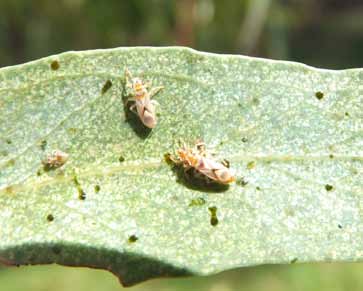PESTS AND DISEASES OF FORESTRY IN NEW ZEALAND
A new eucalypt pest has arrived in New Zealand: Bronze bug
Scion is the leading provider of forest-related knowledge in New Zealand
Formerly known as the Forest Research Institute, Scion has been a leader in research relating to forest health for over 50 years. The Rotorua-based Crown Research Institute continues to provide science that will protect all forests from damage caused by insect pests, pathogens and weeds. The information presented below arises from these research activities.
From Forest Health News 226, June 2012.
An Australian insect not previously known in New Zealand has been found on urban street trees in Auckland. Thaumastocoris peregrinus (Hemiptera: Thaumastocoridae), also known as the bronze bug, is a sapsucker that feeds on the leaves of a variety of Eucalyptus species. The name Thaumastocoris is of Greek origin and, ironically translates as “wonderful bug”. The bug is light brown with dark brown patterns and has a flattened body about 3 mm long. Its eggs are black and are visible to the naked eye. Adults and nymphs may be found in large numbers on the leaves and their feeding causes the leaves to turn from silver and spotted to rusty red. The foliage will wither and drop in severe infestations and this can lead to branch dieback.

In March 2012 T. peregrinus was found on Eucalyptus nicholii during a routine survey by SPS Biosecurity Ltd., conducted as part of the Ministry for Primary Industries’ High Risk Site Surveillance programme. Specimens were identified and validated by morphological examination at Scion and subsequently confirmed by molecular techniques at the Plant Health and Environment Laboratory (PHEL) in Auckland.
Little was known about this insect until damaging outbreaks occurred in its native range in the Sydney area, beginning in 2002. The bug was discovered in South Africa in 2003, where it was identified as T. australicus. In 2005 a very similar species was found in Argentina. Morphological examination revealed unique characteristics that did not match any known species and it was described as a new species, Thaumastocoris peregrinus. It was presumed also to have been introduced from Australia. It was later revealed that this was the same species that had been misidentified in South Africa and was also the dominant species in the Sydney area, with a population in Brisbane as well. DNA barcoding has demonstrated that at least two separate introductions have been made to South Africa, plus another independent one to Argentina. More recently, T. peregrinus has also been found in Italy in 2011. Entry pathways remain unknown.
Once established in these new areas the bronze bug has rapidly spread to neighbouring countries, presumably by both wind and human-mediated dispersal. Its behaviour of readily moving onto objects placed in its path also suggests that it could easily disperse on many vectors, especially birds. In Africa it has spread to Zimbabwe, Malawi and Kenya. In South America during 2008 it was found in both Uruguay and Brazil, and subsequently it has also been reported in Chile and Paraguay.
In New Zealand, an established population exists where it was first detected. A survey conducted in April detected T. peregrinus on trees as far as 3.5 km apart, within a 5 km radius of the initial detection site. It is possible that the bug has spread further afield and surveillance is ongoing.
About 30 species and hybrids of Eucalyptus are known hosts of T. peregrinus. In Australia, recognised hosts are Eucalyptus botryoides, E. camaldulensis, E. dorrigoensis, E. globulus, E. grandis, E. largiflorens, E. microcorys, E. nicholii, E. punctata, E. saligna, E. scoparia, E. sideroxylon, E. tereticornis and E. viminalis. The high populations in Sydney have mostly occurred on E. nicholii and E. scoparia. At least a dozen more hosts have been reported in South Africa, including E. nitens and E. smithii. In addition to several of the hosts mentioned above, E. urophylla appears to be a favoured host in Brazil.

Thaumastocoris peregrinus is considered a serious pest in Australia, South Africa and South America. In Sydney significant numbers of highly infested trees have been removed, but some control has been achieved with systemic insecticides. The egg parasitoid wasps Cleruchoides noackae and Stethynium sp. (Hymenoptera: Mymaridae) have been found to attack T. peregrinus eggs in Australia. Biological control using C. noackae is presently the main international focus of control efforts. In New Zealand this insect may not be eradicable as it appears to be well established, but control options are being considered.
For further information (including overseas references) see Sopow et al. (2012) Bronze Bug, Thaumastocoris peregrinus: A new Eucalyptus pest in New Zealand. Surveillance 39: 43-46.
Stephanie Sopow
This information is intended for general interest only. It is not intended to be a substitute for specific specialist advice on any matter and should not be relied on for that purpose. Scion will not be liable for any direct, indirect, incidental, special, consequential or exemplary damages, loss of profits, or any other intangible losses that result from using the information provided on this site.
(Scion is the trading name of the New Zealand Forest Research Institute Limited.)

 Farm Forestry New Zealand
Farm Forestry New Zealand

